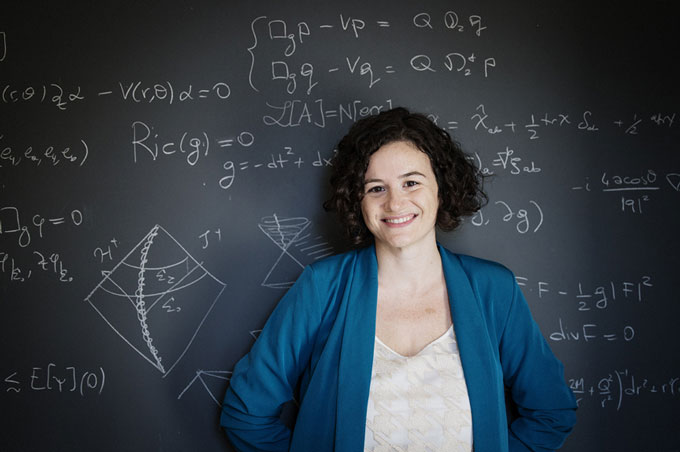This post was originally published on this site
Black holes exist in our universe. That’s widely accepted today. Physicists have detected the X-rays emitted when black holes feed, analyzed the gravitational waves from black hole collisions and even imaged two of these behemoths.
But mathematician Elena Giorgi of Columbia University studies black holes in a different way. “Black holes are mathematical solutions to the Einstein equation,” Giorgi says — the “master equation” that is the basis of the general theory of relativity.
She and other mathematicians seek to prove theorems about these solutions and otherwise probe the math of general relativity. Their goal: unlock unsuspected truths about black holes or verify existing suspicions.

Within general relativity, “one can understand clean mathematical statements and study those statements, and they can give an unambiguous answer within that theory,” says Christoph Kehle, a mathematician at ETH Zurich’s Institute for Theoretical Studies. Mathematicians can solve equations that have bearing on questions about the nature of black holes’ formation, evolution and stability.
Last year, in a paper posted online at arXiv.org, Giorgi and colleagues settled a long-standing mathematical question about black hole stability. A stable black hole, mathematically speaking, is one that if poked, nudged or otherwise disturbed will eventually settle back into being a black hole. Like a rubber band that has been stretched and then released, the black hole doesn’t rip apart, explode or cease to exist, but returns to something like its former self.
Black holes seem to be physically stable — otherwise they couldn’t endure in the universe — but proving it mathematically is a different beast.
And a necessary feat, Giorgi says. If black holes are stable, as researchers presume, then the math describing them had better reflect that stability. If not, something is wrong with the underlying theory.
“Most of my work,” Giorgi says, “is about proving things that we already expected to be true.”
Mathematics has a history of big contributions in the realm of black holes. In 1916, Karl Schwarzschild published a solution to Einstein’s equations for general relativity near a single spherical mass. The math showed a limit to how small a mass could be squeezed, an early sign of black holes. More recently, British mathematician Roger Penrose won the 2020 Nobel Prize in physics for his calculations showing that black holes were real-world predictions of general relativity. In a landmark paper published in 1965, Penrose described how matter could collapse to form a black hole with a singularity at its center.
Just a couple of years earlier, in 1963, New Zealand mathematician Roy Kerr found a solution to Einstein’s equation for a rotating black hole. This was a “game changer for black holes,” Giorgi noted in a public lecture given at the virtual 2022 International Congress of Mathematicians. Rotating black holes were much more realistic astrophysical objects than the non-spinning black holes that Karl Schwarzschild had solved the equations for.
“Physicists really had believed for decades that the black hole region was an artifact of symmetry that was appearing in the mathematical construction of this object but not in the real world,” Giorgi said in the talk. Kerr’s solution helped establish the existence of black holes.
In a nearly 1,000-page paper, Giorgi and colleagues used a type of “proof by contradiction” to show that Kerr black holes that rotate slowly (meaning they have a small angular momentum relative to their mass) are mathematically stable. The technique entails assuming the opposite of the statement to be proved, then discovering an inconsistency. That shows that the assumption is false. The work is currently undergoing peer review. “It’s a long paper, so it’s going to take some time,” Giorgi says.
The result doesn’t yet extend to Kerr black holes that rotate quickly with respect to their mass, which are also known to exist in the universe.
Though the result isn’t likely to upend our view of black holes, these kinds of mathematical journeys can yield new insights.
That’s been true in Giorgi’s study of black holes with an electric charge, which are also solutions to Einstein’s equations. She’s been exploring what happens to those black holes in the face of disturbances that feature both electromagnetic radiation and gravitational waves. These waves may surround black holes, fall inside them or interact with them at a distance, she says. Through that work, she reached a new mathematical definition of electromagnetic radiation that could be used in additional research on charged black holes.
Giorgi has straddled the fields of physics and math since high school, when she realized that “if I know math, I can also do physics.” Her enduring interest in physics and attraction to differential geometry, which deals with geometry of smooth spaces, made general relativity a natural fit. But her straddling has led some colleagues to misunderstand her work.
Some physicists think black hole mathematicians are proving things “more rigorously that they have already sort of proven, that they’re convinced of,” Giorgi says. Meanwhile, some mathematicians consider her work “more physics than math” — that is until they see the length of her full mathematical proofs.
Giorgi likes the freedom she has found in research. “You can choose to work on whatever you want,” she says. “You have to find your own problems.”
